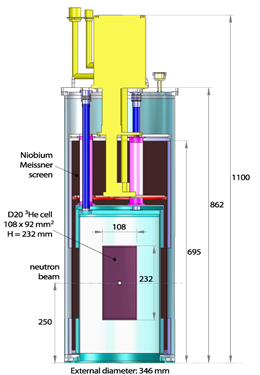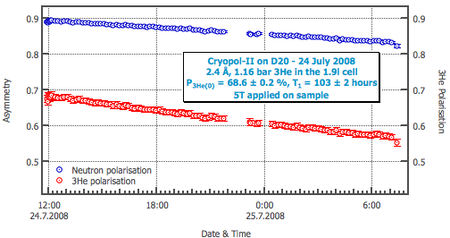Polarised powder diffraction
Spin Polarised Powder Diffraction
E. Lelièvre-Berna, E. Bourgeat-Lami, T. Hansen, P.F. Henry, M. Thomas, X. Tonon, J. Torregrossa, K.H. Andersen, F. Bordenave, P. Courtois, D. Jullien, P. Mouveau, B. Guérard and G. Manzin
Institut Laue-Langevin, 6 rue Jules Horowitz, 38042 Grenoble, France
The Polarised Neutron Technique used on D3 is a very sensitive method and certainly the most powerful tool for determining magnetisation distributions in the whole space of the unit cell. The measurement of polarisation dependent cross-sections reveals unambiguously the spin delocalisation, the polarisation sign, the density shape and the effects of magnetic interactions. Combined with specific data analysis tools, it gives access to very precise quantitative results. It is even sometimes possible to separate precisely the spin and orbital contributions.
However, it only applies to single crystals that are magnetically ordered in a ferro- or ferri-magnetic phase under an applied magnetic field or to particular antiferromagnets. The lack of installation on a powder diffractometer prevents the investigation of most molecular magnets and nano-systems. We have therefore launched the project to use polarised neutrons on powder neutron diffractometers. A first very successful attempt [Wills] has been accomplished on the ILL instrument D1B with the magnetostatic cavity Cryopol hosting a 3He neutron spin filter [Dreyer]. Motivated by the results, we have constructed a second-generation Cryopol (Cryopol-II), a spin rotator optimised for the 20 cm high monochromator and guiding coils.
Cryopol-II is a cryogen-free version that fits the beam profile of D20. The device is a superconducting Nb cylinder hosting a spin filter cell and in which we trap a homogeneous magnetic field. The neutron beam entering Cryopol-II is polarised by the cell. At the exit, a magnetic field is applied parallel or anti-parallel to the field trapped in Cryopol-II (nutator). This way, we flip the neutron polarisation (non-adiabatic fast passage) with a perfect efficiency whatever is the field applied on the sample and the wavelength used.
Cryopol-II is installed inside a cylinder of µ-metal box. The whole system is then surrounded by a soft-iron shield that also contains the nutator. Indeed, the simulations show that a very good magnetic connection is required between the nutator and the Cryopol-II soft-iron shields to screen the stray field of cryomagnets. The preparation of Cryopol-II is quite easy : one puts it inside an end-compensated solenoid producing a homogeneous magnetic field of about 8G and starts the compressor of the cold-head.
On the instrument, we use two nitrogen monitors located before and after Cryopol-II to measure continuously the polarisation of the beam. Indeed, one can easily show that the polarising efficiency of a cell is given by:


where M10 and M20 are the monitor values measured with the 3He gas depolarised. With the D20 spin filter cells (10 x 8 x 22 cm3), the relaxation decay is about 100 hours at 1.2 bar and 120 hours at 2.2 bar, which is clearly enough for powder diffraction measurements lasting a few hours. During an experiment, care must be taken to check the absence of beam depolarisation between Cryopol-II and the sample position due to instrument imperfections. The depolarisation in the sample can be measured with a Heusler crystal fixed to the sample stick for different applied fields and temperatures. We measure [+] and [-] spectra following the [+][-][-][+] repeated sequence so that we do not integrate the variation of the beam polarisation in the data (first order correction).
The polarisation decay remaining quite small inside one measuring sequence [+][-][-][+], we calculate the difference of the [+] and [-] spectra for each sequence. The difference spectra obtained are then corrected for the transmission of the 3He gas and the polarising efficiency of the spin filter which are time dependent functions. The data can then be averaged over all collected sequences and corrected for the transmission of the glass of the cell and depolarisation factor of the sample. We obtain difference spectra proportional to the interference term of the scattering cross-section 4 N M (or to the chiral term for AF systems) whose scale factor is identical to the one of the spectrum collected in the nuclear phase with a non-polarised beam (i.e. without cell). The figure below shows the first difference spectrum collected with Cryopol-II in 8 hours on Prussian Blue at 3K under 5T. This new polarised neutron option is now available on the high-flux powder diffractometer D20 [Hansen].
The same technique could efficiently be implemented at a spallation neutron source. In this case, it is normally possible to place the spin filter at a longer distance from the cryomagnet and the use of a Cryopol becomes unnecessary. The ILL Magic-Box incorporating a 3He spin flipper would be perfect. This box could be mounted on a simple mechanics that puts/removes the spin-filter from the beam. The cell could be polarised using either the SEOP or MEOP techniques. Using a MEOP station, the opacity of the spin filter (pressure) would easily be changed on-line so that its characteristics remain optimum.
References
E. Lelièvre-Berna, A. S. Wills, E. Bourgeat-Lami, A. Dee, T. Hansen, P. F. Henry, A. Poole, M. Thomas, X. Tonon, J. Torregrossa, K. H. Andersen, F. Bordenave, D. Jullien, P. Mouveau, B. Guérard and G. Manzin
Measurement Science and Technology, 21 (2010) 055106 (7pp)
[Wills] A. S. Wills, E. Lelièvre-Berna, A. Sella, F.G. Cloke, P.L. Arnold, F. Tasset, J. Schweizer and R. Ballou, Physica B356 (2005) 254
[Dreyer] J. Dreyer, L.-P. Regnault, E. Bourgeat-Lami, E. Lelièvre-Berna, S. Pujol, M. Thomas, F. Thomas and F. Tasset, Nuc. Inst. Met. Phys. Res. A 449 (2000) 638
[Hansen] T.C. Hansen, P.F. Henry, H.E. Fischer, J. Torregrossa and P. Convert, Meas. Sci. Technol.19 (2008) 034001



